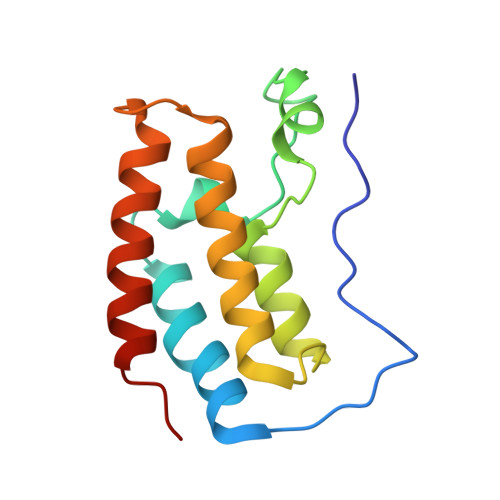Discovery of a Bromodomain and Extraterminal Inhibitor with a Low Predicted Human Dose through Synergistic Use of Encoded Library Technology and Fragment Screening.
Wellaway, C.R., Amans, D., Bamborough, P., Barnett, H., Bit, R.A., Brown, J.A., Carlson, N.R., Chung, C.W., Cooper, A.W.J., Craggs, P.D., Davis, R.P., Dean, T.W., Evans, J.P., Gordon, L., Harada, I.L., Hirst, D.J., Humphreys, P.G., Jones, K.L., Lewis, A.J., Lindon, M.J., Lugo, D., Mahmood, M., McCleary, S., Medeiros, P., Mitchell, D.J., O'Sullivan, M., Le Gall, A., Patel, V.K., Patten, C., Poole, D.L., Shah, R.R., Smith, J.E., Stafford, K.A.J., Thomas, P.J., Vimal, M., Wall, I.D., Watson, R.J., Wellaway, N., Yao, G., Prinjha, R.K.(2020) J Med Chem 63: 714-746
- PubMed: 31904959
- DOI: https://doi.org/10.1021/acs.jmedchem.9b01670
- Primary Citation of Related Structures:
6TPX, 6TPY, 6TPZ, 6TQ1, 6TQ2 - PubMed Abstract:
The bromodomain and extraterminal (BET) family of bromodomain-containing proteins are important regulators of the epigenome through their ability to recognize N -acetyl lysine (KAc) post-translational modifications on histone tails. These interactions have been implicated in various disease states and, consequently, disruption of BET-KAc binding has emerged as an attractive therapeutic strategy with a number of small molecule inhibitors now under investigation in the clinic. However, until the utility of these advanced candidates is fully assessed by these trials, there remains scope for the discovery of inhibitors from new chemotypes with alternative physicochemical, pharmacokinetic, and pharmacodynamic profiles. Herein, we describe the discovery of a candidate-quality dimethylpyridone benzimidazole compound which originated from the hybridization of a dimethylphenol benzimidazole series, identified using encoded library technology, with an N -methyl pyridone series identified through fragment screening. Optimization via structure- and property-based design led to I-BET469, which possesses favorable oral pharmacokinetic properties, displays activity in vivo, and is projected to have a low human efficacious dose.
Organizational Affiliation:
GSK , Gunnels Wood Road , Stevenage , Hertfordshire SG1 2NY , U.K.
















